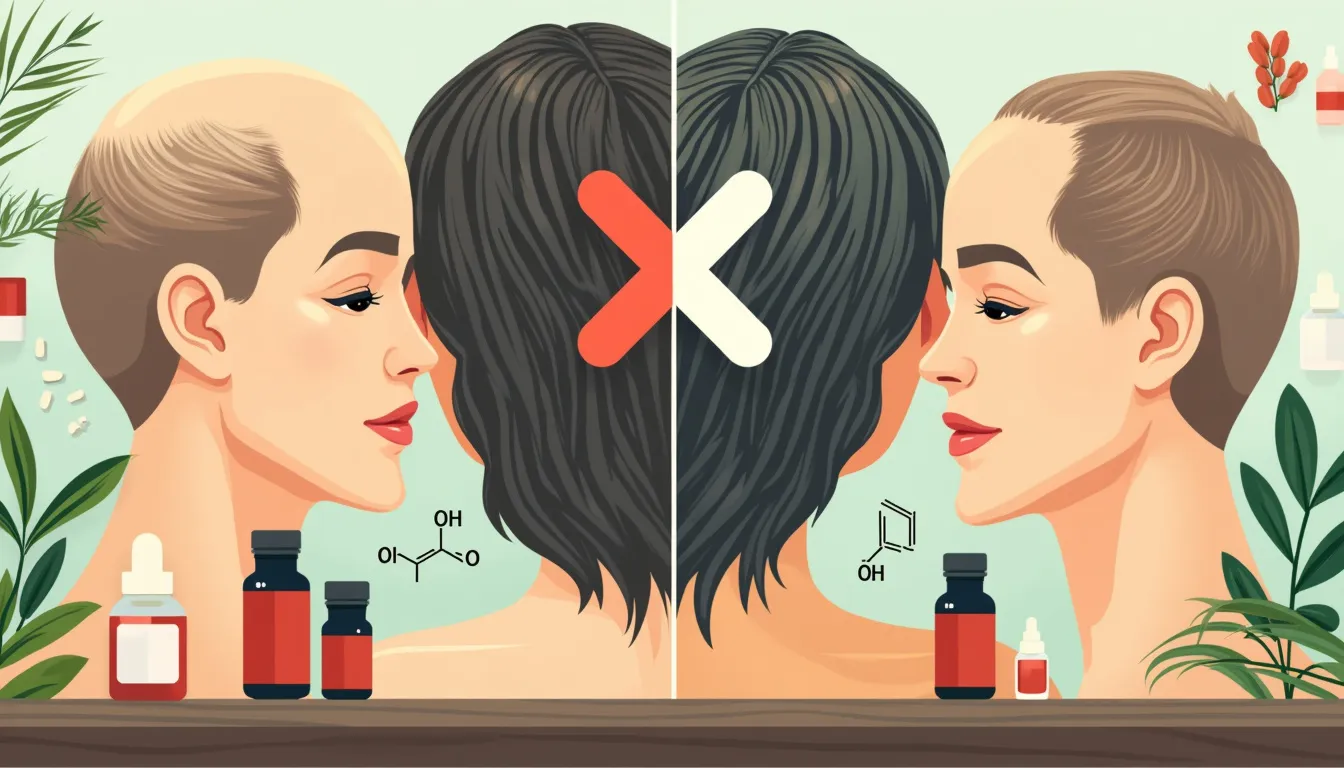Are you tired of watching your hairline recede or noticing more hair in your brush than usual? You’re not alone. Millions of people worldwide grapple with hair loss, and the culprit often lurking behind this common concern is a hormone called DHT. But here’s the good news: understanding DHT and its role in hair loss can be your first step towards reclaiming your luscious locks. In this comprehensive guide, we’ll dive deep into the world of DHT blockers – nature’s secret weapon against hair loss and a key player in promoting hair growth. Whether you’re just starting to notice thinning hair or have been battling baldness for years, this article will equip you with the knowledge you need to fight back. From natural ingredients like saw palmetto and pumpkin seed oil to medical treatments such as finasteride, we’ll explore the wide array of DHT blockers available and how they can help you maintain a full, healthy head of hair. So, if you’re ready to take control of your hair’s destiny and unlock the potential for thicker, fuller hair, keep reading. Your journey to understanding and combating DHT-related hair loss starts here.
Understanding DHT and Its Role in Hair Loss
What is DHT and how it affects hair follicles
Dihydrotestosterone, commonly known as DHT, is a hormone that plays a crucial role in male development and, unfortunately, hair loss. This androgen is derived from testosterone through the action of an enzyme called 5-alpha reductase. While DHT is essential for the development of male characteristics during puberty, it can become problematic for hair health in later years.
DHT affects hair follicles by binding to androgen receptors in the scalp. This binding process can lead to a phenomenon called miniaturization of the hair follicles. Here’s how it works:
- DHT shortens the hair growth cycle (anagen phase)
- It prolongs the resting phase (telogen phase)
- Over time, this leads to thinner, shorter, and more brittle hair
- Eventually, some follicles may stop producing hair altogether
The effects of DHT on hair follicles aren’t uniform across the scalp. Typically, the hair on the crown and frontal hairline is more susceptible to DHT’s influence, which explains the common pattern of male pattern baldness.
The genetic component of DHT sensitivity
While DHT affects everyone to some degree, not all individuals experience hair loss. This difference in response is largely due to genetics. Some people are genetically predisposed to have hair follicles that are more sensitive to DHT.
Research has identified several genes that may contribute to this increased sensitivity:
- The androgen receptor (AR) gene
- The 5-alpha reductase gene
- Various other genes involved in hair growth and hormone regulation
These genetic factors can influence:
- The number of androgen receptors in scalp tissue
- The efficiency of DHT production
- The hair follicle’s response to DHT
It’s important to note that having these genetic predispositions doesn’t guarantee hair loss. Environmental factors and lifestyle choices can also play a role in how these genes are expressed.
Why blocking DHT is crucial for preventing hair loss
Given DHT’s central role in hair loss, blocking its effects has become a primary strategy in hair loss prevention and treatment. DHT blockers work by either reducing the production of DHT or preventing it from binding to androgen receptors in the scalp.
Here’s why DHT blockers are so crucial:
- They address the root cause: Unlike treatments that only stimulate hair growth, DHT blockers target the underlying mechanism of hair loss.
- They can slow or stop hair loss progression: By reducing DHT’s effects, these blockers can help maintain existing hair and prevent further loss.
- They may promote regrowth: In some cases, blocking DHT can allow miniaturized follicles to recover and produce healthier, thicker hair.
- They offer a long-term solution: As long as the DHT blocking continues, its protective effects on hair follicles persist.
It’s worth noting that the effectiveness of DHT blockers can vary depending on factors such as the individual’s genetic predisposition, the extent of hair loss, and how early treatment begins. Generally, DHT blockers are most effective when used early in the hair loss process.
There are various types of DHT blockers available, ranging from natural supplements to prescription medications. Some popular options include:
- Saw palmetto
- Finasteride (a prescription medication)
- Pumpkin seed oil
- Green tea extract
Each of these works slightly differently, but all aim to reduce the impact of DHT on hair follicles. It’s important to consult with a healthcare professional before starting any DHT-blocking regimen, especially when considering prescription options.
While DHT blockers are a powerful tool in the fight against hair loss, they’re often most effective when used as part of a comprehensive hair care strategy. This might include proper nutrition, stress management, and the use of other hair growth-promoting treatments.
Understanding the role of DHT in hair loss is the first step in effectively combating this common issue. By targeting DHT, individuals can take proactive steps to maintain their hair and potentially regrow what’s been lost. As research in this field continues to advance, we can expect even more effective DHT-blocking strategies to emerge, offering hope to millions affected by hair loss worldwide.

Natural DHT Blockers: Ingredients and Their Effectiveness
When it comes to combating hair loss, many people are turning to natural DHT blockers as a safer alternative to synthetic medications. These natural ingredients have shown promising results in reducing DHT levels and promoting hair growth. Let’s explore some of the most effective natural DHT blockers and their potential benefits.
Saw Palmetto: A powerful natural DHT blocker
Saw Palmetto is perhaps the most well-known natural DHT blocker. This extract, derived from the berries of the Serenoa repens plant, has been used for centuries in traditional medicine. Recent studies have shown that Saw Palmetto can be effective in blocking the enzyme 5-alpha-reductase, which is responsible for converting testosterone into DHT.
A 2002 study published in the Journal of Alternative and Complementary Medicine found that 60% of participants who took Saw Palmetto extract experienced improved hair growth. This natural ingredient works by:
- Inhibiting 5-alpha-reductase enzyme activity
- Reducing DHT levels in the scalp
- Promoting hair follicle health
While more research is needed to fully understand its efficacy, many hair loss prevention products incorporate Saw Palmetto as a key ingredient due to its potential DHT-blocking properties.
Pumpkin Seed Oil and its DHT-blocking properties
Another promising natural DHT blocker is Pumpkin Seed Oil. Rich in phytosterols, essential fatty acids, and antioxidants, this oil has shown potential in promoting hair growth and reducing hair loss.
A 2014 study published in Evidence-Based Complementary and Alternative Medicine found that men who took pumpkin seed oil supplements for 24 weeks saw a 40% increase in hair count compared to those who took a placebo. The DHT-blocking effects of pumpkin seed oil are attributed to its:
- High content of phytosterols, which may inhibit 5-alpha-reductase
- Anti-inflammatory properties that support scalp health
- Nutrient-rich composition that nourishes hair follicles
Incorporating pumpkin seed oil into your diet or using hair care products containing this ingredient may help in your fight against hair loss.
Green Tea Extract and its potential in hair loss prevention
Green tea extract, particularly its active compound epigallocatechin gallate (EGCG), has shown promise as a natural DHT blocker. Known for its numerous health benefits, green tea extract may also play a role in promoting hair growth and preventing hair loss.
A 2007 study published in the Journal of the National Medical Association found that EGCG from green tea extract could inhibit the growth of human hair follicle cells in vitro. While this may seem counterintuitive, the researchers suggested that this inhibition could actually help in treating androgenetic alopecia by:
- Regulating hair growth cycles
- Potentially blocking DHT receptors in hair follicles
- Providing antioxidant protection to hair follicles
While more research is needed to fully understand the mechanisms of green tea extract in hair loss prevention, incorporating it into your hair care routine may offer some benefits.
Other natural ingredients with DHT-blocking effects
Several other natural ingredients have shown potential as DHT blockers, although research on their effectiveness is still ongoing. Some of these include:
- Rosemary Oil: A 2015 study published in Skinmed found that rosemary oil was as effective as minoxidil in promoting hair growth in people with androgenetic alopecia.
- Pygeum Bark Extract: This extract from the African cherry tree has been shown to have anti-androgenic effects and may help in reducing DHT levels.
- Nettle Root Extract: Rich in compounds that may inhibit 5-alpha-reductase, nettle root extract is often used in natural hair loss treatments.
- Beta-Sitosterol: This plant sterol, found in various foods and herbs, has shown potential in blocking DHT and promoting hair growth.
While these natural DHT blockers show promise, it’s important to note that their effectiveness can vary from person to person. Additionally, the concentration and quality of these ingredients in different products can significantly impact their efficacy.
For those looking to explore natural DHT blockers as part of their hair loss prevention strategy, it’s worth considering a comprehensive approach. Programs like Fortify offer a holistic solution that combines various natural ingredients to target DHT and promote hair growth.
Remember, while natural DHT blockers can be effective, they work best when combined with a healthy lifestyle, proper nutrition, and good hair care practices. It’s always advisable to consult with a healthcare professional or trichologist before starting any new hair loss treatment regimen, especially if you have underlying health conditions or are taking medications.

Synthetic DHT Blockers and Medical Treatments
When it comes to combating hair loss, synthetic DHT blockers and medical treatments often provide more potent and scientifically proven results compared to natural alternatives. These options are typically recommended for individuals experiencing significant hair loss or those who haven’t found success with natural remedies. Let’s explore some of the most effective synthetic DHT blockers and medical treatments available.
Finasteride: The Most Common Prescription DHT Blocker
Finasteride, commonly known by its brand name Propecia, is the gold standard in prescription DHT blockers. This oral medication works by inhibiting the enzyme 5-alpha reductase, which is responsible for converting testosterone into DHT. By reducing DHT levels in the scalp, finasteride helps to slow down hair loss and promote hair regrowth.
Key points about finasteride:
- FDA-approved for treating male pattern baldness
- Typically prescribed in a 1mg daily dose
- Studies show it can reduce DHT levels by up to 70%
- Effective in about 80% of men who use it consistently
- Results may take 3-6 months to become noticeable
While finasteride is highly effective, it’s important to note that it’s only prescribed for men and is not suitable for women, especially those who are pregnant or may become pregnant, due to potential risks to male fetuses.
Minoxidil: A Topical Treatment that Complements DHT Blockers
Although not a DHT blocker itself, minoxidil is often used in conjunction with DHT blockers to enhance hair regrowth. This topical treatment, available over-the-counter under brand names like Rogaine, works by improving blood flow to the scalp and prolonging the anagen (growth) phase of the hair cycle.
Benefits of minoxidil:
- Available in 2% and 5% solutions or foams
- Suitable for both men and women
- Can be used on its own or in combination with DHT blockers
- May help regrow hair and slow further loss
- Results typically visible after 3-4 months of consistent use
When used together, finasteride and minoxidil can provide a powerful one-two punch against hair loss, addressing both DHT-related follicle miniaturization and blood flow issues.
Comparing the Effectiveness of Natural vs. Synthetic DHT Blockers
While natural DHT blockers have their merits, synthetic options like finasteride generally offer more robust and consistent results. Here’s a quick comparison:
| Aspect | Natural DHT Blockers | Synthetic DHT Blockers |
|---|---|---|
| Effectiveness | Moderate | High |
| Scientific backing | Limited studies | Extensive clinical trials |
| Speed of results | Slower (6-12 months) | Faster (3-6 months) |
| Consistency of results | Variable | More consistent |
| Side effects | Generally fewer | Potentially more significant |
It’s worth noting that while synthetic options may be more potent, they also come with a higher risk of side effects. This is why many people prefer to start with natural alternatives before moving on to prescription treatments.
Potential Side Effects and Considerations When Using DHT Blockers
As with any medical treatment, DHT blockers can come with potential side effects. It’s crucial to be aware of these and discuss them with a healthcare provider before starting treatment.
Potential side effects of finasteride:
- Decreased libido
- Erectile dysfunction
- Decreased ejaculate volume
- Gynecomastia (breast enlargement in men)
- Depression or mood changes
It’s important to note that these side effects are relatively rare, affecting only a small percentage of users. However, in some cases, they can persist even after discontinuing the medication, a condition known as Post-Finasteride Syndrome (PFS).
Minoxidil side effects are generally milder and may include:
- Scalp irritation
- Unwanted hair growth in other areas
- Temporary shedding in the first few weeks of use
When considering DHT blockers, it’s essential to weigh the potential benefits against the risks. Factors to consider include:
- The severity of your hair loss
- Your overall health and any pre-existing conditions
- Your willingness to commit to long-term treatment
- Your comfort level with potential side effects
Remember, consistency is key when using DHT blockers. These treatments typically need to be used continuously to maintain results, as stopping treatment can lead to a reversal of any gains made.
For those looking for a comprehensive approach to hair loss prevention, consider exploring Fortify, a program designed to help stop hair loss through a combination of proven techniques and treatments.
In conclusion, while synthetic DHT blockers and medical treatments offer powerful tools in the fight against hair loss, they should be approached with careful consideration and under the guidance of a healthcare professional. By understanding the options available and their potential impacts, you can make an informed decision about the best course of action for your hair health journey.
In conclusion, DHT blockers have emerged as a crucial tool in the fight against hair loss and the promotion of hair growth. Whether you opt for natural ingredients like saw palmetto and pumpkin seed oil or synthetic options like finasteride, these blockers offer hope for those struggling with hair loss. However, it’s essential to remember that the effectiveness of DHT blockers can vary from person to person, and results may take time to become noticeable.
While DHT blockers can be powerful allies in maintaining a healthy head of hair, they are just one part of a comprehensive approach to hair care. A balanced diet, proper hair hygiene, stress management, and overall health also play significant roles in hair health. It’s always advisable to consult with a healthcare professional or trichologist before starting any new hair loss treatment regimen, especially when considering synthetic DHT blockers that may have potential side effects.
As research in this field continues to advance, we can expect to see even more effective and targeted DHT-blocking treatments in the future. For now, those concerned about hair loss have a range of options to explore, from natural remedies to medical treatments. By understanding the role of DHT in hair loss and the various blocking methods available, individuals can make informed decisions about their hair care strategy and take proactive steps towards maintaining a fuller, healthier head of hair.
Remember, while hair loss can be distressing, it’s a common issue that affects millions of people worldwide. With the right approach and persistence, many individuals find success in slowing or even reversing hair loss using DHT blockers and other hair growth strategies. Don’t hesitate to take action – your journey to healthier, fuller hair could start today.
